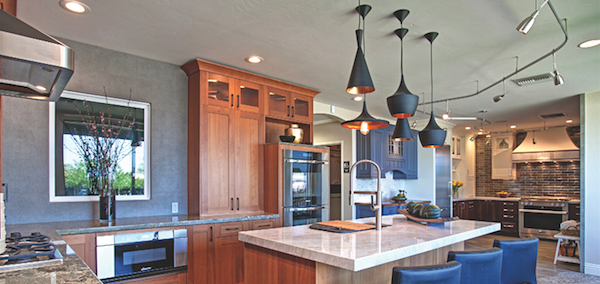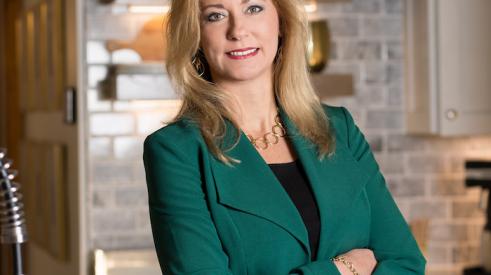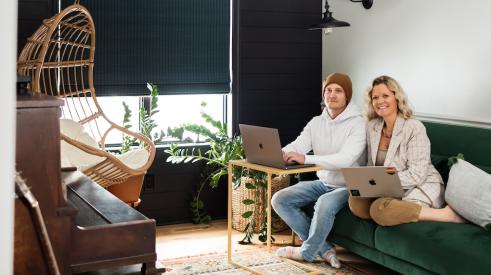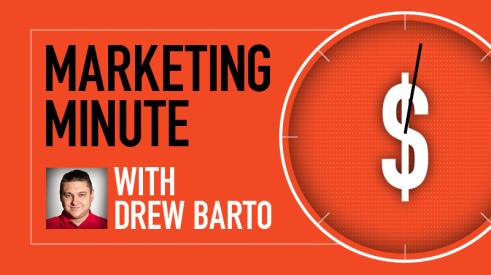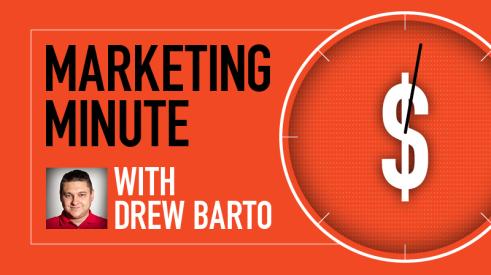R.I. Kitchen & Bath
Steve St. Onge, founder and president of R.I. Kitchen & Bath, has maintained a showroom for the entire 26 years that his company has been in business. The original location was small—just 1,400 square feet, including offices—with low ceilings and no curb appeal. To supplement his product displays, St. Onge would take clients to the showrooms of tile and plumbing businesses on an industrial street in the next town over. When he decided to change locations, he found a building on that same street. “It’s easy to get to and there is no extraneous retail traffic,” St. Onge explains.
Although walk-in business is a significant part of the client base (15 percent so far in 2015), most people meet by appointment, so the showroom stays open past business hours only on Thursdays, and is open for four hours on Saturdays. Still, improving curb appeal was a big reason for the move, after St. Onge discovered that a couple who had just signed a contract for a sizeable kitchen renovation with one of his designers hadn’t even bothered to pull into R.I. Kitchen & Bath’s parking lot when they first saw his original storefront. Only a friend’s recommendation prompted the couple’s second try.
The new, modern, 10,000-square-foot space (below) has a 3,000-square-foot showroom in front, with design and administrative offices in the middle. The warehouse/shop space in the back is critical because it is company policy that no job is started until all cabinets, fixtures, and fittings have been delivered to the shop, the boxes opened, and the contents inspected to ensure that the order is correct, complete, and undamaged.
Having everything under one roof also means that St. Onge can offer clients a behind-the-scenes tour of his operation. “We show them how we actually make the sausage,” St. Onge says. “It adds credibility. Many clients are so impressed by our organization that it seals the deal.”
The high ceilings in the new space also make it easy to locate and supply power to displays. And, unlike the old space, whose low ceilings and narrow commercial entry limited the ability to move display components in and out, the new showroom has a 15-foot wide, 10-foot-high hallway connecting the showroom to the warehouse through 10-foot-tall decorative French doors.
Making the move was risky, partly because the company took on debt and partly because of bad timing: St. Onge signed the lease in January 2008. But after an initial slowdown during the recession, the company actually grew during the downturn, adding a VP of sales and marketing position, doubling the number of designers from three to six, and also adding three technical designers. “If you’re good at what you do, you’ll outgrow your space faster than you think,” St. Onge says. “So plan for 10 to 15 years out.”
In addition to initial cost to build out the space, upkeep is a major investment. The showroom has three or four “core” displays with universal appeal, which are updated only after three to five years. Several smaller vignettes are altered more frequently to keep up with new products and trends. Some of these start as portable displays built in the warehouse for use in home shows, then when the show season ends, they’re used to replace vignettes on the showroom floor.
St. Onge points out that a showroom may not be right for everyone, especially if there are already good options in your area. But if that’s not the case, he recommends building one. Not only will it immediately differentiate you from your competition, he says, “It will give you the brick-and-mortar credibility needed to command a higher price in your marketplace.” But don’t neglect to budget for regular upkeep and maintenance. “There’s no bigger turn-off for a potential client than a poorly maintained showroom,” he says.
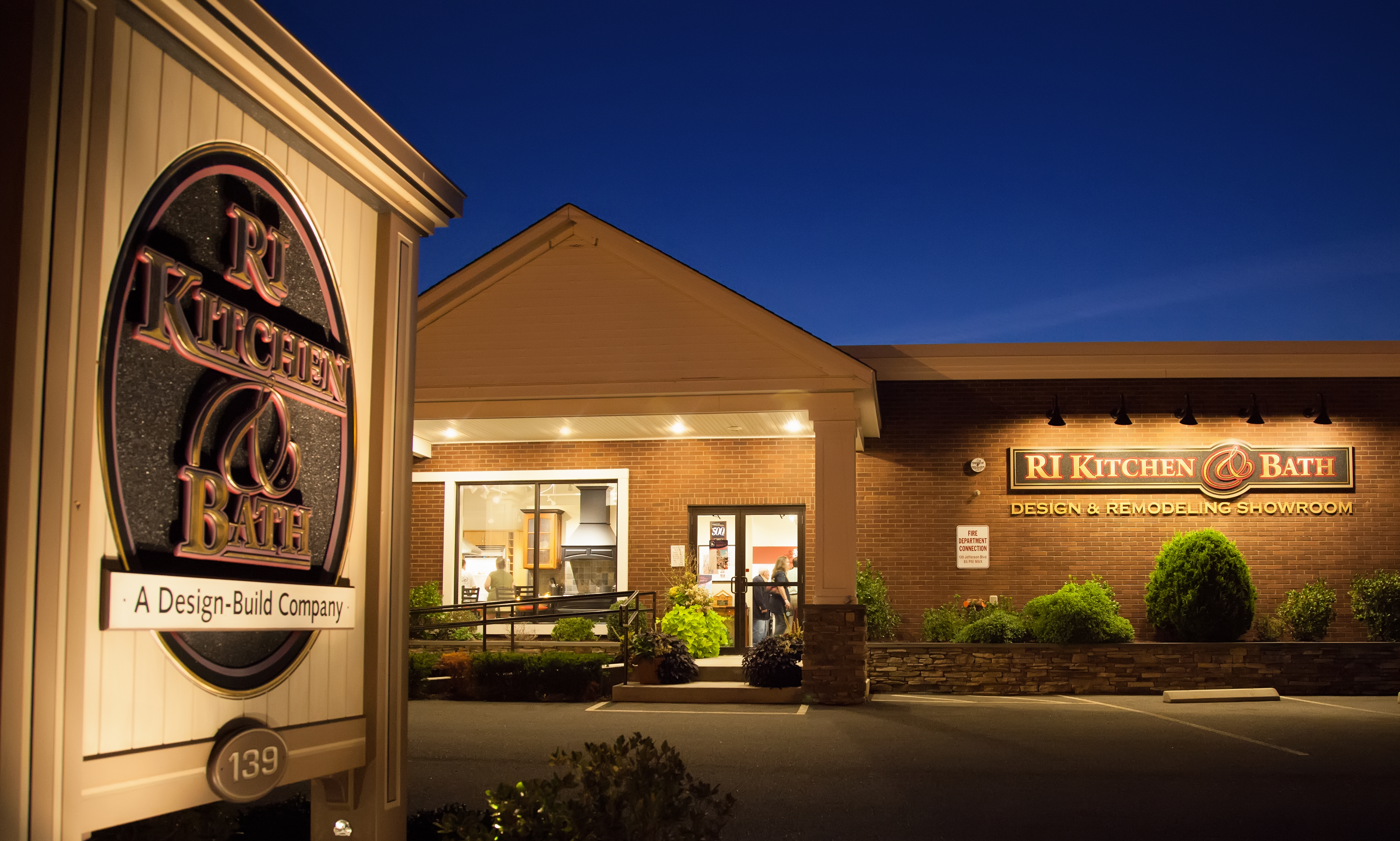
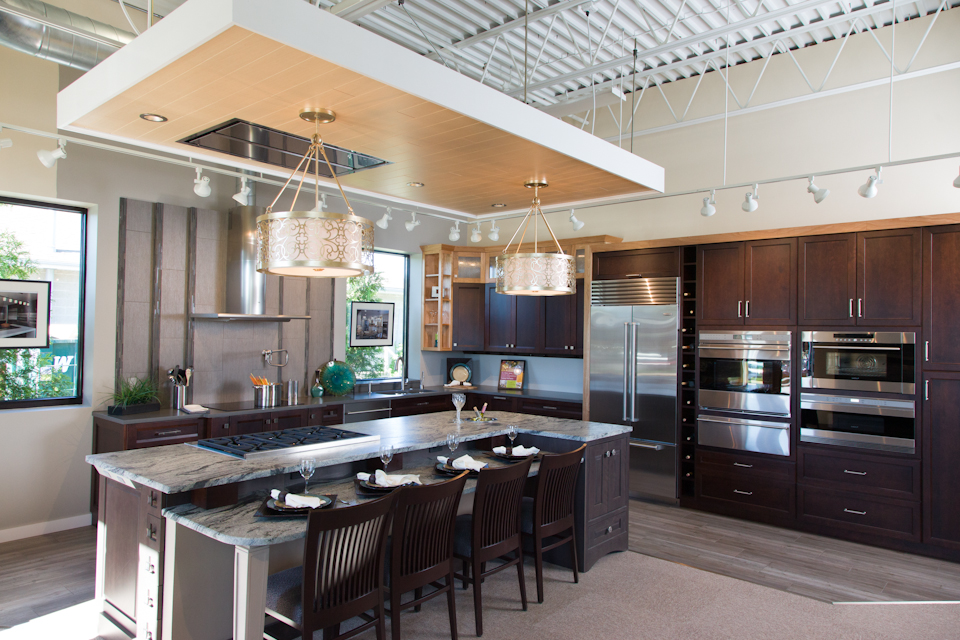
Lack of space and curb appeal at its original location prompted R.I. Kitchen & Bath’s move to a larger, more modern building (top). Open trusses and high ceilings makes it easy to drop electrical power to displays regardless of where they are located in the showroom (middle). Three or four “core” displays are upgraded every three to five years, while smaller vignettes are updated more often as design trends and products change (bottom).
Normandy Design Build Remodeling
For 15 of his 16 years with Normandy Remodeling, designer Vince Weber has worked out of the company’s facility in the western Chicago suburb of Hinsdale (below). The building houses an 8,000-square-foot “showroom and design center” on the first floor and offices for management, sales, architecture, and construction on the second.
The central location does attract some walk-in traffic, but most clients meet by appointment after seeing an ad or a truck sign, or being referred by a friend or relative. And that’s just the way Normandy likes it. “The showroom is less about walk-in traffic and more about the client experience,” Weber says. “It’s about being able to walk them through and make the selection and buying process as easy and stress-free as possible.” In addition to a showroom manager who is on duty during weekday business hours, the 20 designer sales staff rotate showroom duty to ensure that a designer is always available.
Several full bathrooms and kitchens are on display, plus a series of smaller vignettes that showcase several cabinet lines for which Normandy is a dealer, including one that they private label. Additional cabinet samples can be found in a dedicated “selection center” that also holds samples of countertops, plumbing fixtures, tile, and other products.
Because the company is a Pella Certified Contractor and a Kohler Showroom, dedicated areas of the building are devoted to those manufacturers’ products. Normandy is also a Wolf/Sub-Zero Showroom and maintains a strong relationship with Abt Electronics, a large national appliance and electronics retailer in nearby Glenview that has dedicated salespeople to handle Normandy clients and does all of Normandy’s installations.
Designers also have access to large-screen monitors, which they use to visit websites to find products that they formerly used print catalogs to locate. But one of the most important ways they use the digital displays is to look at a client’s Pinterest or Houzz account. Like everything else in the showroom and design center, “It helps to set client expectations so we can steer them in the right direction,” Weber says. “We’re very good at investigating and really understanding what their needs are. We try to limit the selections to fit that need, so that they’re not overwhelmed.”
The space has evolved over the years. In 2000, when the company first moved in, it occupied 6,000 square feet for showroom and offices. In 2007, the company took over the remainder of the first floor and built out the added space as a selection center. In 2010, it took over the entire second floor for offices.
“It didn’t happen overnight,” says Andy Wells, general manager and co-owner of Normandy. “It was expensive and time consuming—and worth every penny because it gives an enormous sense of credibility to our staff when selling the concepts of remodeling.”
Lead generation is also an important function of the showroom. ”People don’t just stop in,” Wells says. “You need a reason for them to come in.” For example, one kitchen is equipped with working ranges that are used for customer appreciation events or special demonstrations.
As the space has changed, so has the role it plays in the Normandy design and sales process. “Five to eight years ago, there was more emphasis on the showroom post-sale,” Weber says. “Since then, it’s been much more a tool for the sales process itself. It helps with credibility and comfort for a client.”
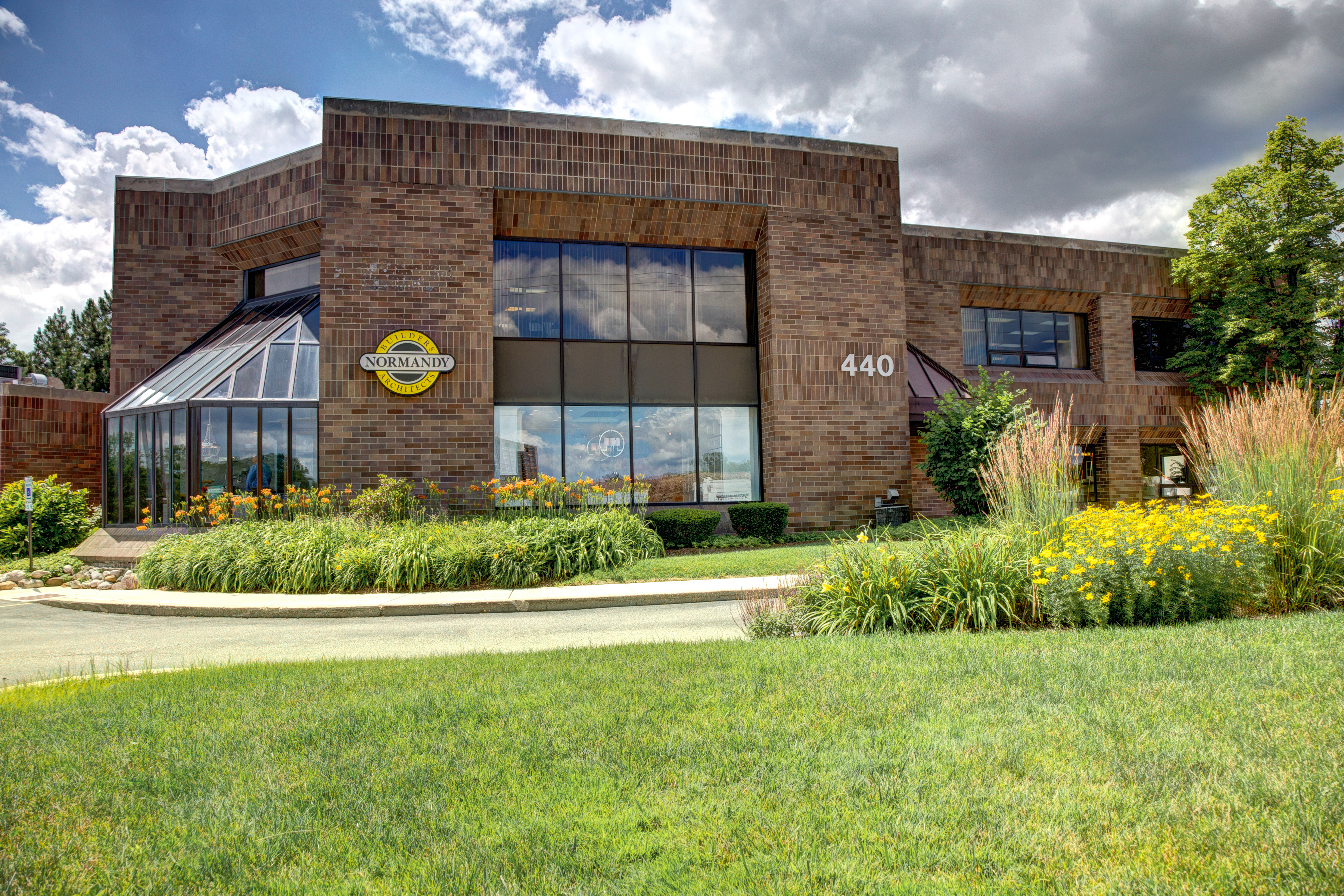
In 2000, when Normandy moved into a new building, it occupied 6,000-square-feet for offices and showroom (top). By 2010, the company had added a selection center to the first-floor showroom (middle) and was using the second floor for offices. In 2013, an old display was removed to make room for a drop-down screen and seating for the two dozen educational seminars the company holds annually, each of which typically draws from 20 to 80 people (bottom).
Custom Design & Construction
This September, Custom Design & Construction will celebrate its fourth year in its new space just south of the Los Angeles International Airport. Company president Bill Simone is careful to note that he and his team always refer to the space as a “design center,” not a showroom. “The intent is to showcase the talent of our designers,” Simone says. “And because our crews built everything on display, it also shows clients the level of craftsmanship clients can expect.”
Initially, the company had little more than a conference room that held some product sample displays. Bill and his partners knew they needed more space, so when a former manufacturing space became available, the company made the 12-mile move from north of the airport to south of the airport. It took a year to renovate the space, which included not only building out the 3,000-square-foot design center (below), but adding restrooms and 3,000 square feet of offices, plus constructing a mezzanine level over half of the floor space, which is used for storage.
The location is unique, and it held a few surprises. Among them: The company discovered that LAX, which sits between Custom Design & Construction’s old and new locations, is an unofficial dividing line—people north of the airport don’t travel to the south side, and vice versa. So all marketing had to retarget a new audience.
The other surprise was that a good chunk of that new audience was walk-in traffic. The old location was in a nondescript office building that generated almost no walk-ins, so Simone expected the same at the new space. Then Custom Design discovered the lunch crowd.
“Our neighbors are major corporations, like Boeing and Raytheon. Mattel is right next door, Direct TV is around the corner,” Simone explains. “We’re on the main thoroughfare between this industrial area and the local restaurants. These companies have a rolling lunch hour, so from about 11 a.m. to 2 in the afternoon, we started to get lots of lunchtime walk-in traffic.”
As a result, Simone and his team came up with a lunchtime lead-generation strategy that involves inviting upscale food trucks to set up in front of the showroom once or twice a week. The food trucks Tweet their location to their huge following, and Simone provides a printed flier that the vendors hand out with every meal. Anyone who wanders into the showroom is greeted by company staff, who capture contact information and invite them to tour the displays. The goal is to get walk-ins to schedule an appointment with a designer, and the track record is pretty good: 23 percent of the company’s 2014 revenue came from walk-in traffic.
The company now supplements its regular marketing campaigns with an extended event-marketing strategy that includes cooking demonstrations with guest chefs, wine tastings, and educational seminars. It even makes the space available to third-party groups, such as Direct TV, which recently held a team-building event for 35 employees in the design center space.
Simone appreciates the fact that things could have turned out differently, but the company has adapted well. “It was really dumb luck that we ended up here,” he says. “The lesson learned is to really research the area you’re going to move to. We completely missed that we would get all of this walk-in traffic. But on the positive side, we turned it to our advantage.”
Four years ago, Custom Design & Construction renovated and moved into a former manufacturing plant in an industrial section on the south side of LAX (top). To capitalize on walk-in traffic from employees of several neighboring corporations, the company invites upscale food trucks to set up out front several times a week (middle). The result: Sales to walk-ins went from next to zero at Custom Design’s former location to a quarter of its 2014 revenue. Its marketing strategy also includes cooking demonstrations, wine tastings, and educational seminars in the design center (bottom).
Jackson Design & Remodeling
Located just 5 miles north of downtown San Diego, Jackson Design & Remodeling’s 8,000-square-foot “inspiration center” creates what company president, Todd Jackson, calls a “high design, high touch” client experience. The many displays include kitchens, baths, and outdoor rooms, all of which are designed to inspire clients to a custom design. In the current product-selection process, designers accompany clients to a subset of some 25 or 30 third-party showrooms. And the system works: From about 1,500 leads per year, the inspiration center produces about 100 high-end projects averaging about $135,000 each.
That’s the good news. The bad news is that the emphasis on high-end remodeling means the company misses out on a lot of mid-level business: Last year alone it referred about 600 projects to companies that are better equipped to deal with a simple gut-and-replace jobs. But as Jackson sees it, even a modest kitchen could run $65,000 or more. That’s potential revenue.
Jackson’s first solution was to acquire a company to handle that end of the business. But recently, the property next door, which contains two buildings, came up for sale. It didn’t take Jackson long to decide to buy it. He plans to rent out the smaller 7,000-square-foot building, and is renovating half of the 9,000-square-foot space to house a completely new venture that he will brand as Home Expressions. Jackson calls the new building a “selection center,” and it will handle both interior and exterior products.
“You didn’t hear me say ‘inspiration center’ or ‘showroom,’” he says. We’ll still have some vignettes, but the plan is to create a selection center that will offer a wider range of products in a good-better-best approach.”
The new space will be staffed by designer-salespeople who will work on commission. The goal is to generate 100 to 125 projects averaging about $50,000 each.
But there are many other advantages to locating a completely new venture right next door. “It doesn’t water down the brand,” Jackson says. “I spent a lot of years nurturing the high-end brand, and I don’t want to jeopardize that. Plus, it’s easier to start at the high end and take it down a notch than to work it the other way around.”
The ability to carry a wide range of product samples will also streamline the selection process, which in turn will make it possible to maintain a lower design fee for mid-level projects. It also gives Jackson an opportunity to leverage some of the strong alliances he already has. For example, Jackson has negotiated a discount with a tile vendor that is setting up and managing a mini-store within the new space based on increased traffic and the ease of making a transaction. The new building also offers an opportunity to cross-sell the company’s window and door replacement business. Finally, the new building will also devote 2,500 square feet to offices for production, accounting, and human resources staff for both companies, which will provide some relief in the existing building.
But the big advantage is the ability to attract a whole new clientele. “We’re now servicing both ends of the spectrum, the high-end and the midrange clientele,” Jackson says. And with the two buildings right next to each other, a mid-level client who walks into the “wrong” building can be escorted across the parking lot to Home Expressions, and vice versa. That stands to recover a lot of business that used to be referred away. PR
Jackson Design & Remodeling’s “inspiration center” uses full displays of high-end kitchens (top), baths, and outdoor rooms (middle) to engage prospects in what president, Todd Jackson, calls a “high-design, high-touch” experience. The result is about 100 projects each year averaging $135,000. But the company also refers away about 600 middle-market prospects each year. To capture that market, Jackson recently acquired the property next door (bottom) and is remodeling it into a “selection center” that will generate another 100 projects in the $50,000 range.
We talked with remodelers about what it takes to build, maintain, and operate a showroom, and how it fits into the way they do business.
Add new comment
Related Stories
How to Get More Leads with a Stronger Remodeling Brand
Discover how to build a strong brand for your construction company, and learn key strategies to differentiate and attract better leads
Building A Small Projects Division from the Ground Up
Through hard work and careful strategy, Harth Home Services has seen big growth
Helping Remodelers 'Get Their House In Order'
From remodeler to NARI executive to industry consultant, Diane Welhouse uses her expertise to help business owners
Finding Success Online and on the Jobsite
The Molitors started with humble blog beginnings, and now the couple runs an unlikely two-folded business for social media marketing and design-build construction
How Much Are Window and Roofing Contractors Spending on Marketing?
Director of Home Improvement Drew Barto reveals the percentage of revenue replacement window, door, and roofing contractors of various sizes are spending on marketing in 2023
4 Things for Remodelers to Understand About Google Analytics 4
The new era of Google Analytics is here, and it's set to help you make better marketing decisions through in-depth metrics
The Empty Chair: Customer Experience Will Differentiate Your Business
With all signs pointing to a softer market, how can remodelers remain strong and different from the rest? Pro Remodeler's Director of Content Erika Mosse shares real examples.
Marketing Minute: How to Overcome a Drop in Demand
Director of Home Improvement Drew Barto shares tips on how to survive and thrive in periods of lower demand for your products or services
Do You Have a Healthy Marketing Mindset?
Use your marketing calories wisely and form healthy habits today to keep your business in shape



